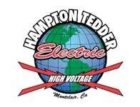Safeguarding the Public
Construction sites can be dangerous if the correct controls are not utilized to mitigate work zone hazards. Construction sites often include machinery, heavy objects and moving vehicles. Workers on site shall be responsible for implementing and maintaining a safe work zone to keep both the public, and employees safe by clearly demarcating the work zone. This allows visual and physical barriers to protect the public from work area hazards, and protects employees from public vehicles which are passing by or near the work area.
Every effort should be made to protect the public at all times when Company work is in progress by the use of signs, barricades, or personal warning. Barricades shall be placed at all open manholes, exposed open ditches and excavations. Where necessary, open ditches and excavations should be substantially boarded over to prevent pedestrians, animals, or vehicles falling into them.
During the night and in all dark locations, barricades with lights should be in place at any obstruction, excavation, or opening which is likely to cause injury to employees or to be the public. When working on customers’ premises or public property, every effort shall be made to avoid hazards to persons or unnecessary property damage. All tools, equipment and excess material should be removed from the site when the job is completed. All employees should be aware of unauthorized persons in the work area and take appropriate action if deemed necessary.
Housekeeping
Maintaining good housekeeping practices can mitigate workplace hazards. Workplace incidents are frequently caused as a direct result of poor housekeeping. Housekeeping requires keeping work areas neat and orderly, maintaining halls and floors free of slip, trip and fall hazards, and removing waste materials. For good housekeeping to effectively prevent incidents, housekeeping must be an ongoing program, and not a periodic cleanup.
Work areas should be cleaned up as soon as the job is completed and, when necessary, while the work is in progress. Scrap material of salvage value should be properly stored until disposed of. Dirty and oily waste rags shall be deposited in an appropriate metal container with a closed lid provided for that purpose, and be disposed of as soon as practical to avoid fire hazard. All customers’ premises and Company equipment (including vehicles) shall be left in a clean and safe condition.
Walks, aisles, stairways, fire escapes, and all other passageways should be kept clear of all obstructions. Tools and materials should not be placed where they may cause tripping or stumbling hazards, or where they may fall and strike anyone below. All spills should be cleaned up promptly. Nails in boards, such as those removed from scaffolds, forms and packing boxes, should be removed. The boards should be carefully stacked or stored.
Hoses, Cables, Cords, and Wire
Hoses, cables, cords, and wires must not be run across any street or area in which vehicles are allowed to drive over them. Significant injuries can occur if they become caught or pulled by a passing vehicle. If in the current work site configuration a hose, cable, cord, or wire must be run across an area that a vehicle can access, the job site must be rearranged not to allow vehicles to pass over them, or cable guards and/or traffic control must be present to prevent vehicles from driving over them.
